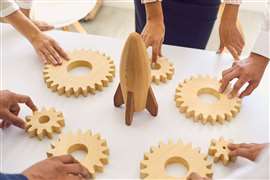Low profile, high lifts: Holland Lift's expansion and growth plans
19 March 2009

Holland Lift is about as far as you can imagine from the world of the major manufacturers - in machines, in manufacturing and in outlook - and that's the way that Menno Koel likes it.
In fact, it is remarkable to think that the company, although a famous name in the access business, currently only sells in 10 or 11 countries, in Europe, and doesn't even have representation in markets as significant as France and Italy.
Mr Koel, who joined Holland Lift as a salesman in 1998 and worked under the successive ownerships of Terex Corp and US investor Roger Tracy, says the modest geographical coverage isn't because they are lazy, far from it, "We started in 2001 with a turnover of €4.5 million and we will do €18 million this year [2008]," he says. The target for 2009 is over €20 million, despite the downturn.
Mr Koel and his business partner, finance director Pieter Boogert, now run the business as joint owners, having bought out Mr Tracy in September 2007 with the help of an Amsterdam private equity company that also has a significant shareholding. However, Mr Koel says he and Mr Boogert have been in effective control of the business since 2002, with Roger Tracy taking an ‘arms length' approach, "We are responsible, good or bad," he says.
Production in 2008 was around 350 machines and Mr Koel wants to increase that to about 500 in two to three years. These are still tiny numbers in comparison to the giants of the industry, but that's part of the appeal, "We will never be able to flood the market, which is a good thing for rental customers," he says. There are just 20 of the company's 34 m scissors working in the Netherlands, for example, and only five in the UK.
Holland Lift's machines cost more than standard models, of course, but are designed to last - over ten years is common. Menno Koel refers to high platform capacities, big decks, good stability and long service intervals as the key benefits, as well as some very particular niche machines, such as the new N-265, a 28.5 m working height, 1.3 m wide unit typically used by companies installing high-level racking systems inside warehouses.
This niche aspect is what gives Mr Koel confidence that the company will grow through the current economic conditions. "The equipment we make is not competing with the big players. There is still work for the machines; there is still a margin in them. Customers value the extra that our machines offer," he says.
Holland Lift has a backlog of orders stretching through to the start of 2010, with lead times varying from three to over 12 months depending on the model. Mr Koel's claim that the company's machines have so far been less impacted by the economic downturn is supported by the example of one of its biggest customers in the Netherlands, Noordwijk-based HWS Verhuur. One of HWS's joint managing directors, Paul van Boven, tells Access International that it is cutting its investment in new machines from 120 units in 2008 to just 15 this year, and all 15 will be Holland Lift models.
Holland Lift is certainly investing in its future. At the start of November it opened a new 6000 m2 facility across the road from its existing main factory in Hoorn, giving it a total of 16000 m2 production space. This represents an investment of over €1 million. Some 60 people are employed in Hoorn, with a further 80-100 people working with steel fabrication and painting subcontractors in the Czech Republic, Slovakia and the Netherlands.
Still, growing the business to 500 units a year will represent a big challenge for the company. Mr Koel says the aim is to move into new European markets, "Every year we concentrate on adding one or two dealers - we're not in for a quick deal. If we can't offer service, we won't start." He says Italy, France and Portugal are the main targets for 2009. "If partners are enthusiastic and loyal they will find in us a loyal partner."
These initiatives will be important in reducing Holland Lift's reliance on its domestic market, which accounts for around 45% of its sales, and also on a core of large customers, with Riwal and its European subsidiaries being the prime example.
The European focus that has been a hallmark of the company will remain, for the time being, "Our philosophy is that we need to be even stronger in our home base - continental Europe," explains Mr Koel, "We would have to cover the whole of Europe, and then go abroad."
Product development continues as ever (see box story), and it is surprising to note that Martin Haak, the original founder of Holland Lift who sold the business to NBB in the 90s, is still the main designer. Mr Haak works at an engineering business called Haak & van Ham BV, based near Haarlem.
Much of the development is in the larger sized machines. "At the moment, we see more and more business going to middle and higher machines. On the smaller models, the competition is beating each other up. That's a game we can't play," says Mr Koel, happy to draw another distinction between Holland Lift and the big players.
Holland Lift has been a quiet success story - maybe the European access industry's best kept secret but, perhaps it is now time for the company to introduce itself to the rest of the world.




